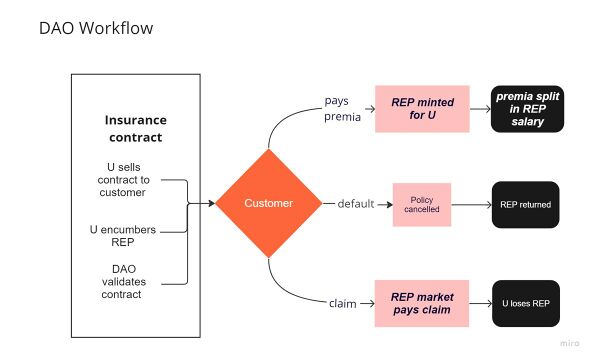Decentralized underwriting: Difference between revisions
Jump to navigation
Jump to search
m (→Workflow) |
|||
| Line 20: | Line 20: | ||
# <math>U_1</math> encumbers the canonical amount of REP in the contract. | # <math>U_1</math> encumbers the canonical amount of REP in the contract. | ||
# Contract Validated by DAO. | # Contract Validated by DAO. | ||
# Customer | # Customer | ||
# DAO | #* pays premia, or | ||
#* defaults, or | |||
#* claims | |||
# DAO | |||
#* mints REP for <math>U_1</math> proportional to premia & distributes REP salary, or | |||
#* cancels contract, or | |||
#* pays claim by selling encumbered REP at market | |||
[[File:IDAO workflow.jpg|border|593x593px]] | [[File:IDAO workflow.jpg|border|593x593px]] | ||
Revision as of 08:42, 19 May 2023
??Insurance DAOs (iDAOs) for creating decentralized underwriting markets, based on this paper.[1]
Insurance DAO protocols
Components
- DAO = {Underwriters}
- Underwriter ∋ REP tokens a) Propose contracts with REP b) Police contracts with REP
- Insurance contract (Work smart contract)
- Validation Pool
Token scheme
Workflow
(See Figure 1.)
- Underwriter sells a contract to a customer.
- encumbers the canonical amount of REP in the contract.
- Contract Validated by DAO.
- Customer
- pays premia, or
- defaults, or
- claims
- DAO
- mints REP for proportional to premia & distributes REP salary, or
- cancels contract, or
- pays claim by selling encumbered REP at market
Figure 1: iDAO workflow follows basic DGF workflow iterated each time a premium is paid.
Notes:
- If a customer makes a claim on the policy, the contract governs how the claim is validated. Typically an oracle and an adjudicator are necessary for this step, which are outside the scope of this specification.
- If a claim is validated, the underwriter's encumbered REP is auctioned at market to pay the claim.
- If the auction price of the encumbered REP is sufficient to cover the claim, and excess cash or REP from the auction is returned to the underwriter.
- If the auction price of the encumbered REP is insufficient to cover the claim, further REP is minted and sold at market until the claim is covered. Any excess cash from this process is donated to the iDAO's capital reserve.
Consequences
Properties engendered
- More auditable/transparent
- More stable, trustworthy
- More meritocratic (rewards and punishment are isolated to the agent)
- Democratized access to participation at all levels
Tokenomics
Capital reserves can be eliminated
economic justification
Where we stand practically in deFi
Missing:
- (d) oracles
- *adjudication
- (d/e) stable coin
- (e) smart contracts
- regulatory clarity
Code
See Also
Notes & References
- ↑ Craig Calcaterra, Wulf A. Kaal, & Vadhindran K. Rao, (2019) "Decentralized Underwriting". Available at https://papers.ssrn.com/sol3/papers.cfm?abstract_id=3396542 (Retrieved 2023 March 16)

